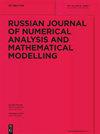A new tool for studying seasonality and spatio-temporal structure of ENSO cycles in data and ESM simulations
IF 0.6
4区 数学
Q4 MATHEMATICS, APPLIED
Russian Journal of Numerical Analysis and Mathematical Modelling
Pub Date : 2024-02-10
DOI:10.1515/rnam-2024-0003
引用次数: 0
Abstract
In this work, we present a new diagnostic tool for El Niño Southern Oscillation (ENSO) simulations in Earth System Models (ESMs) based on the analysis of upper ocean heat content data. It allows us to identify the seasonally dependent structure of temperature anomalies in the equatorial Pacific Ocean in the form of a dominant spatio-temporal pattern. We demonstrate the results of applying a tool to analysis of real data as well as climate simulations in two versions of the Institute of Numerical Mathematics ESM. We find that the latest version of the model, with improved parameterizations of clouds, large-scale condensation, and aerosols, provides significantly better reproduction of ENSO-related structure of anomalies, as well as the phase locking of ENSO to the annual cycle. We recommend to use the tool for diagnostic analysis of ESMs regarding simulation of climate phenomena with strong seasonality.研究数据和 ESM 模拟中厄尔尼诺/南方涛动周期的季节性和时空结构的新工具
在这项工作中,我们根据对上层海洋热含量数据的分析,为地球系统模式(ESM)中的厄尔尼诺南方涛动(ENSO)模拟提出了一种新的诊断工具。它使我们能够以主导时空模式的形式识别赤道太平洋温度异常的季节性结构。我们展示了在数值数学研究所的两个版本的 ESM 中应用该工具分析真实数据和气候模拟的结果。我们发现,最新版本的模式改进了云、大尺度凝结和气溶胶的参数设置,明显更好地再现了与厄尔尼诺/南方涛动相关的异常结构,以及厄尔尼诺/南方涛动与年周期的相位锁定。我们建议使用该工具对模拟具有强烈季节性的气候现象的 ESM 进行诊断分析。
本文章由计算机程序翻译,如有差异,请以英文原文为准。
求助全文
约1分钟内获得全文
求助全文
来源期刊
CiteScore
1.40
自引率
16.70%
发文量
31
审稿时长
>12 weeks
期刊介绍:
The Russian Journal of Numerical Analysis and Mathematical Modelling, published bimonthly, provides English translations of selected new original Russian papers on the theoretical aspects of numerical analysis and the application of mathematical methods to simulation and modelling. The editorial board, consisting of the most prominent Russian scientists in numerical analysis and mathematical modelling, selects papers on the basis of their high scientific standard, innovative approach and topical interest.
Topics:
-numerical analysis-
numerical linear algebra-
finite element methods for PDEs-
iterative methods-
Monte-Carlo methods-
mathematical modelling and numerical simulation in geophysical hydrodynamics, immunology and medicine, fluid mechanics and electrodynamics, geosciences.

 求助内容:
求助内容: 应助结果提醒方式:
应助结果提醒方式:


